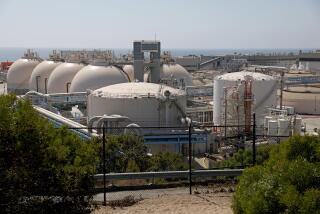Study finds unreported contamination
Los Angeles County public health officials failed to document more than 90% of raw sewage spills that have occurred since 2002, largely because city, county and state agencies did not report them, according to a study released Wednesday.
Most of the 208 potentially health-threatening sewage spills between January 2002 and July 2006 were neither officially recorded nor cleaned up, according to the 24-page report by the Los Angeles County auditor-controller.
The results point to a long-standing failure in communication among local wastewater managers, county public health officials and regional water quality officials, who are responsible for monitoring and reacting to water quality problems.
An earlier investigation, in response to a sewage spill in 2001, concluded that the county’s notification policies were adequate and clearly defined. County officials are now questioning that finding.
“That no evidence exists as to whatever happened to 9.7 million gallons of raw sewage over a 55-month period is abhorrent,” county Supervisor Don Knabe said in a news release. “That’s the equivalent of nearly 15 Olympic-sized swimming pools and no one has any idea of what happened to the raw sewage.”
When the reported incidents are added, the total sewage spilled during that period amounts to more than 11.6 million gallons.
Public health officials contend that the agencies who failed to report the spills are at fault.
“It wasn’t that we weren’t documenting [sewage spills], we just weren’t told about them,” said Jonathan Fielding, the county’s public health director. “We have to get people to do a better job reporting that.”
The county study was prompted by an incident last August in which more than 20,000 gallons of raw sewage leaked into Ballona Creek, spread into Santa Monica Bay and closed two miles of beaches.
Environmental groups, which do their own monitoring of spills, assisted with the report.
The study found the vast majority of spills were due to poor maintenance or improper use.
“We need to reform what the county has legal authority to do, but this is also a call to other agencies who were a part of this failure,” said Knabe’s spokesman, David Sommers.
The report calls on the county to establish clearer standards and a stricter timeframe for reporting sewage spills to public health officials, calling the current laws “vague and confusing.” It also suggests boosting the county’s authority to fine cities and individuals who fail to notify the county.
“Any city that has a spill has an obligation to tell the health department about that spill as soon as humanly possible, and that has not been happening,” said Mark Gold, executive director of the environmental group Heal the Bay, which assisted with the study.
Gold would like to see a mandatory reporting time of two hours. The current standard is the state requirement of 24 hours, he said. “There’s no reason that it should take that long to report a sewage spill.”
The investigation looked into all spills of 1,000 gallons or more that occurred in the Santa Monica Bay watershed over a 4 1/2 -year period. It comes after several major spills which, while reported, put the county under heavy criticism for its slow response time.
A failure of a pumping station in Manhattan Beach last January discharged 1.5 million gallons of sewage into the ocean and coastal groundwater, closing beaches for days. The spill was called the largest in Santa Monica Bay in a decade.
The Sanitation Districts of Los Angeles County last month agreed to pay $2.5 million to settle a dispute with the Los Angeles Regional Water Quality Control Board and Santa Monica Baykeeper, an environmental group, over the handling of the spill.
Knabe will introduce plans for reform at the Board of Supervisors meeting Tuesday.
More to Read
Sign up for Essential California
The most important California stories and recommendations in your inbox every morning.
You may occasionally receive promotional content from the Los Angeles Times.










